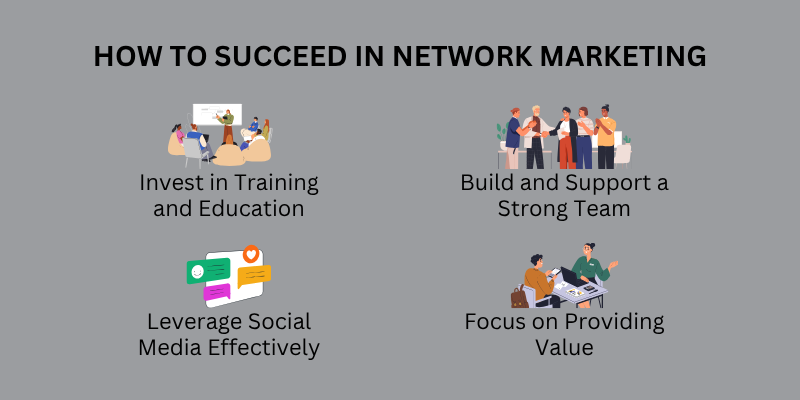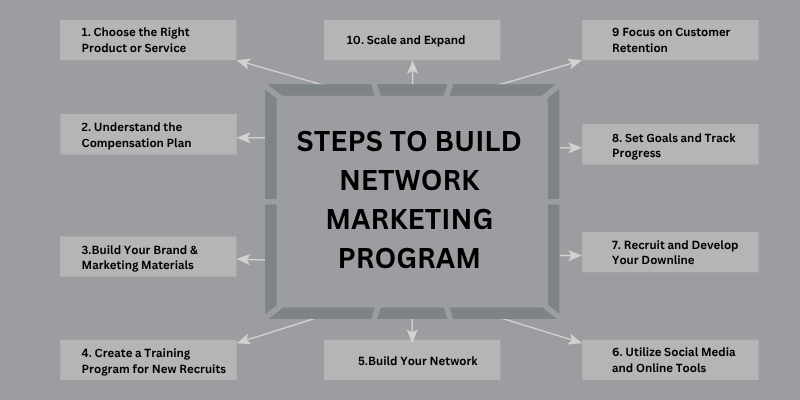Have you ever wondered how some individuals build thriving businesses without the overhead of a physical storefront or a large team of employees?
Network marketing offers a compelling answer to this question.
Network marketing, also known as multi-level marketing (MLM), is a business model that leverages personal networks to distribute products and services.
It’s estimated that 7.3 million Americans are involved in network marketing.
While network marketing has proven to be a game-changer for many entrepreneurs, enabling them to build businesses from the ground up using their networks and relationships, it’s essential to approach it with a clear understanding of what it entails.
Success in this field requires more than just enthusiasm; it demands strategic planning, consistent effort, and a genuine belief in the products you’re promoting.
In this guide, we’ll explore the fundamentals of network marketing, its potential benefits, and the challenges you might face.
Whether you're considering it as a side hustle or a full-time venture, understanding the intricacies of this business model will help you make an informed decision and set you on the path to success.
What is Network Marketing?
Network marketing, also known as multi-level marketing (MLM), direct selling, or referral marketing, is a business model where individuals sell products or services directly to consumers and earn commissions not only from their own sales but also from the sales made by others they recruit into the business.

For example, advertisement examples of successful MLM campaigns can often show how this model thrives by leveraging personal networks and word-of-mouth marketing. This creates a network of distributors, forming a hierarchical structure where earnings are derived from both personal sales and the sales generated by recruits.
In addition, oil and gas advertising agency can benefit from incorporating network marketing strategies to promote their services to clients, leveraging the power of personal relationships and recruitment to expand their reach in this specialized industry.
MLM Structure
In an MLM system, individuals join as independent distributors and are encouraged to recruit others to join as well.
Understanding b2b vs b2c can help refine marketing strategies, as MLM often operates in a B2C (business-to-consumer) manner, though recruitment can involve B2B elements. Each distributor earns commissions from their direct sales and may also receive a percentage of the sales made by their recruits, known as their "downline."
The structure typically resembles a pyramid, with each level representing a tier of recruits. The more individuals a distributor recruits, the larger their downline becomes, potentially increasing their earning potential.
How It Works?
Distributors in a network marketing company earn income through two primary avenues:
- Direct Sales: Distributors sell products directly to consumers and earn a commission on each sale.
- Recruitment and Team Sales: Distributors recruit new individuals to join the business. They earn commissions not only from their own sales but also from the sales made by their recruits and the recruits of their recruits, creating multiple levels of income. In this regard, understanding how to search for words on a page can help distributors quickly access relevant product details or compensation plan specifics, especially when handling large amounts of information.
This dual-income stream incentivizes distributors to both sell products and expand their network of recruits.
Key Terminology in Networking Marketing You Must Know
- Downline: The individuals recruited into the business under a specific distributor. A distributor's downline can include direct recruits and further recruits made by those individuals.
- Upline: The person who recruits others into the network. A distributor's upline includes the individual who recruited them and the recruits of that individual.
- Commission: Earnings made from the products sold by the individual and their downline. Commissions are typically a percentage of the sales price and can vary based on the compensation plan of the MLM company.
Understanding these key components is crucial for anyone considering entering the network marketing industry, as they form the foundation of how income is generated within this business model.
History and Growth of Network Marketing
Network marketing, also known as multi-level marketing (MLM), has a rich history that dates back to the early 20th century. What is B2B marketing, It’s a great question to ask if you’re exploring B2B MLM models or integrating business-to-business marketing approaches within the network marketing industry.
The origins of network marketing can be traced to companies like Avon and Nutrilite, which began utilizing direct selling methods to distribute their products.
In the 1950s, the MLM model began to gain significant traction with the founding of Amway by Jay Van Andel and Rich DeVos in 1959.
During this period, companies like Shaklee and Mary Kay expanded the reach of MLM, offering a diverse range of products and opportunities for individuals to build their own businesses.
Over the decades, network marketing has evolved into a multi-billion-dollar industry.
As of 2025, the global network marketing industry is projected to reach $650 billion, with over 90 million people participating worldwide.
In recent years, the rise of digital technology and social media has transformed network marketing.
Platforms like Facebook, Instagram, TikTok, and YouTube have become essential tools for MLM distributors, enabling them to reach a global audience with minimal investment.
To enhance your brand’s digital presence, integrating global creative services can help you create compelling content and marketing campaigns that resonate with your target audience.
If you are looking to enhance your online presence as an MLM distributor, using the best website builder for SEO can be a game-changer in ensuring your business gets maximum visibility on search engines.
This digital shift has democratized access to network marketing, empowering individuals from diverse backgrounds to participate and succeed.
Additionally, the emphasis on authenticity and community-building resonates with younger generations, particularly Gen Z, who value genuine connections and transparency from brands.
As a result, network marketing continues to adapt and thrive in the digital age, offering individuals a flexible and scalable business opportunity.
How Does Network Marketing Work?
Network marketing operates on a dual-income model: earnings from personal product sales and commissions from building a network of distributors. Keyword ranking report software can help distributors monitor the effectiveness of their digital marketing strategy, ensuring the products they are promoting rank well on search engines.

In addition to traditional sales tactics, many distributors may explore other marketing channels, including paid advertising. For instance, understanding Google Ads cost is essential if you’re looking to expand your reach and advertise your network marketing business online. By calculating and optimizing your budget for Google Ads, distributors can create effective campaigns that attract potential customers and recruits.
Furthermore, utilizing company branding services can help establish a strong, recognizable brand identity, making it easier to differentiate your network marketing business from competitors and build trust with your target audience.
Here's an in-depth look at how it functions:
Compensation Plans
Network marketing companies employ various compensation structures to reward distributors:
1. Binary Plan
Distributors build two teams, known as "legs"—a left and a right.
ommissions are based on the sales volume of the weaker leg. For example, if the left leg generates $1,000 in sales and the right leg generates $1,500, the distributor earns commissions based on the $1,000 from the weaker leg.
However, it requires careful management to maintain balance between legs.
2. Unilevel Plan
Distributors can recruit an unlimited number of people directly beneath them, forming a single levels.
Commissions are earned from the sales made by these direct recruits and, in some cases, their recruits, depending on the depth allowed by the company.
However, the potential for less emphasis on team development.
3. Hybrid Plan
Combines elements of multiple compensation plans, such as binary and unilevel.
Distributors can earn from various sources, including direct sales, team sales, and bonuses.
However, it can be complex and may require more effort to understand and manage.
To successfully navigate this complexity, companies often benefit from Digital Branding Services to ensure their compensation structure and overall marketing strategy are aligned with their brand’s goals and message.
Retail Sales
A core aspect of network marketing is the sale of products or services to end consumers.
Distributors earn a profit margin on these sales, which is typically the difference between the wholesale price they pay to the company and the retail price they charge customers.
This aspect emphasizes the importance of product knowledge and customer service in building a successful network marketing business.
If you're looking to expand your skill set beyond network marketing, learning how to get into digital marketing could provide new opportunities to further your career and reach a broader audience.
Understanding these components is crucial for anyone considering a career in network marketing.
The Pros and Cons of Network Marketing
However, like any business venture, it comes with its own set of advantages and challenges.
Here's a look at the pros and cons of network marketing:
|
Pros of Network Marketing |
Description |
Cons of Network Marketing | Description |
|
Low Startup Costs |
Compared to traditional businesses that require significant capital for inventory, storefronts, or employees, network marketing often has minimal initial investment. This accessibility makes it an attractive option for individuals seeking entrepreneurial opportunities without hefty financial commitments. |
High Attrition Rate | A significant challenge in network marketing is the high turnover rate. Many individuals join with enthusiasm but may not achieve the desired success, leading to early exits. Factors contributing to this include unrealistic expectations, lack of proper training, and insufficient support. |
|
Flexible Work Schedule |
Network marketing allows individuals to set their own hours, offering flexibility that is especially beneficial for stay-at-home parents, retirees, or those seeking a side income. This autonomy enables distributors to balance work with personal commitments. |
Reputation Concerns | Network marketing often faces criticism due to associations with pyramid schemes, where earnings are primarily derived from recruitment rather than product sales. This stigma can make it challenging to recruit new members and build trust with potential customers. Similarly, if you’re wondering is affiliate marketing legit, it’s important to understand that, like network marketing, success depends on building a sustainable and ethical business model, rather than focusing solely on recruitment. |
|
Residual Income Potential |
One of the most appealing aspects of network marketing is the opportunity to earn passive income. By building a network of distributors (downline), individuals can earn commissions not only from their sales but also from the sales made by their recruits, creating a stream of income that can grow over time. |
Dependency on Recruitment | Success in network marketing heavily depends on the ability to recruit and build a downline. This reliance on recruitment can be challenging, especially if individuals are not skilled in sales or do not have a broad network to tap into. Companies that face these challenges can benefit from branding services to establish a strong identity and build trust with both recruits and customers. |
How to Succeed in Network Marketing?
Achieving success in network marketing requires a strategic approach, continuous learning, and a commitment to providing value.

For instance, if you’re trying to understand how does Shopify work within a network marketing framework, it’s critical to integrate e-commerce platforms seamlessly with your network marketing efforts. Similarly, leveraging website SEO services will help you optimize your online presence, ensuring your e-commerce store and marketing efforts are easily discoverable by your target audience through search engines.
Here's how you can excel in this field:
1. Invest in Training and Education
Continuous personal development is crucial in network marketing. Engage in training programs that enhance your sales techniques, communication skills, and leadership abilities.
Learning from experienced mentors can provide valuable insights and strategies to navigate the challenges of the industry.
Additionally, staying informed about industry trends and best practices can give you a competitive edge. Integrating tools like PIM solutions can also help you manage and streamline product information, making it easier to communicate details to your team and prospects effectively.
2. Build and Support a Strong Team
Success in network marketing often hinges on the strength of your team. Focus on recruiting individuals who are motivated and align with your business values.
Provide comprehensive training and ongoing support to help your team members succeed.
Fostering a positive and collaborative environment can lead to increased productivity and retention within your downline.
3. Leverage Social Media Effectively
Social media platforms are powerful tools for expanding your reach and connecting with potential customers and recruits.
Share authentic content that showcases your products and personal experiences. Engage with your audience by responding to comments, participating in discussions, and providing valuable information and use content marketing tools to schedule posts and track engagement across platforms like Facebook, Instagram, or LinkedIn.
Additionally, if you are diversifying your marketing strategy, understanding what is high ticket affiliate marketing can help you create a more lucrative revenue stream by promoting high-value affiliate products alongside your network marketing efforts.
Consistency and authenticity in your online presence can build trust and credibility.
4. Focus on Providing Value
Rather than solely emphasizing recruitment, prioritize offering genuine value to your customers and team members.
Understand their needs and provide solutions that enhance their lives. Building trust through value-driven interactions can lead to long-term relationships and sustained success in network marketing.
10 Step Build A Network Marketing Program
Creating a successful network marketing program involves a structured approach, strategic planning, and dedication to building relationships.

Here’s a step-by-step guide to help you get started:
1. Choose the Right Product or Service
It's crucial to select a product you believe in, are passionate about, and that offers real value to your target audience.
This product should also have strong market demand and stand out from the competition.
Before launching, conduct thorough market research to ensure your product or service fills a need and has potential for growth in your niche.
2. Understand the Network Marketing Compensation Plan
Before starting, it’s important to fully understand the compensation plan of the network marketing company you are working with.
This will help you set realistic income expectations and guide you in achieving your financial goals. Familiarize yourself with how commissions, bonuses, and residual incomes are structured.
3. Build Your Brand and Create Marketing Materials
Developing a strong and recognizable brand is essential for long-term success in network marketing.
Your brand should reflect your values, your passion for the product, and the benefits it offers to customers. Create marketing materials such as business cards, brochures, and a website that effectively communicate the value of your product and the business opportunity.
These materials will act as your business tools, helping you promote your network marketing program and establish trust with your audience.
4. Create a Training Program for New Recruits
Create an onboarding system that introduces new recruits to your business model, product, and compensation plan. Provide comprehensive training through online resources, webinars, and one-on-one sessions.
Make sure your recruits understand the importance of both direct sales and recruitment, as well as how to build a successful downline.
5. Build Your Network
Start by reaching out to your existing circle of friends, family, and colleagues. Personal connections can be a great way to begin building your downline.
Use your network to spread the word about your business opportunity and the products you’re selling.
As you grow, expand your network by meeting new people and reaching out through social media platforms like Facebook, Instagram, and LinkedIn.
6. Utilize Social Media and Online Tools
Share relevant and engaging content such as product demonstrations, testimonials, and valuable tips that can help both customers and potential recruits.
You can incorporate Social Ads and Performance Marketing strategies to enhance your reach and engagement.
Use online tools like email campaigns, CRM systems, and sales funnels to automate and track your efforts.
With consistency and effective online marketing strategies, you can expand your network and grow your business faster.
7. Recruit and Develop Your Downline
Focus on attracting motivated individuals who share your vision and are committed to building their own network marketing business.
Train your recruits to sell products and recruit others, creating a solid foundation for future growth.
Provide ongoing support and mentorship to help them develop their skills and achieve their goals. Remember, a strong downline will lead to exponential business growth.
8. Set Goals and Track Progress
Establish clear, measurable goals for yourself and your team. These could include specific sales targets, recruitment numbers, or income milestones.
Break down larger goals into smaller, achievable steps to keep yourself and your recruits on track. Use CRM tools or spreadsheets to track performance and assess what’s working and what’s not. Regularly review your p
9. Focus on Customer Retention
Building lasting relationships with your customers is just as important as recruitment. Regularly check in with customers to ensure they’re satisfied with your products and services.
Offer loyalty programs, exclusive deals, or valuable content to keep them engaged.
Ask for feedback to improve the products or services you offer. Happy customers not only return but can also refer others, contributing to your overall business growth.
10. Scale and Expand
Once you’ve established a successful network marketing business, consider expanding to new markets.
You can scale your business by growing your downline, increasing sales, or targeting new demographics. Look for opportunities to expand into other regions, countries, or online marketplaces.
The key to scaling successfully is ensuring your team is well-trained and supported, and that your marketing strategies are adaptable to different markets.
By following these steps and continuously evolving your approach, you can grow a sustainable business that offers flexibility, residual income, and the opportunity to help others achieve financial independence.
FAQs
Is network marketing good or bad?
Network marketing can be good for those who have the skills to sell and build a team, but it can be bad if it relies on recruitment rather than product sales, leading to potential pyramid schemes.
What are the three types of network marketing?
The three main types of network marketing are single-level marketing (SLM), multi-level marketing (MLM), and matrix marketing.
How can I start network marketing?
To start network marketing, choose a reputable company, learn about their products, build a network, and focus on both selling and recruiting new members.
Can anyone do network marketing?
Yes, anyone can do network marketing, but success depends on effort, selling skills, and the ability to build and manage a network.
Conclusion
Network marketing offers a unique and flexible business model that allows individuals to earn income through direct sales and recruitment. Its potential lies in the ability to build a business from the ground up with minimal startup costs, the flexibility to work from anywhere, and the opportunity to earn residual income by building and managing a downline. However, it also comes with challenges, such as high attrition rates, reputation concerns, and a heavy reliance on recruitment. Ultimately, network marketing can be a great opportunity for those who enjoy sales, have a strong work ethic, and seek entrepreneurial flexibility. It provides a platform for personal growth, skill development, and the chance to build a sustainable business over time, but success requires dedication, persistence, and a focus on offering real value to customers and recruits alike.









